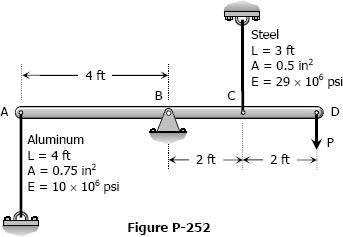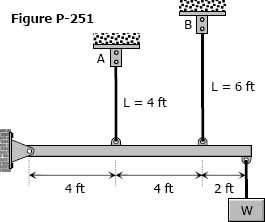Thermal Stress
Temperature changes cause the body to expand or contract. The amount δT, is given by
where α is the coefficient of thermal expansion in m/m°C, L is the length in meter, Ti and Tf are the initial and final temperatures, respectively in °C. For steel, α = 11.25 × 10-6 m/m°C.
If temperature deformation is permitted to occur freely, no load or stress will be induced in the structure. In some cases where temperature deformation is not permitted, an internal stress is created. The internal stress created is termed as thermal stress.
- Read more about Thermal Stress
- Log in to post comments
Solution to Problem 257 Statically Indeterminate
Problem 257
Three bars AB, AC, and AD are pinned together as shown in Fig. P-257. Initially, the assembly is stress free. Horizontal movement of the joint at A is prevented by a short horizontal strut AE. Calculate the stress in each bar and the force in the strut AE when the assembly is used to support the load W = 10 kips. For each steel bar, A = 0.3 in.2 and E = 29 × 106 psi. For the aluminum bar, A = 0.6 in.2 and E = 10 × 106 psi.

Solution to Problem 256 Statically Indeterminate
Problem 256
Three rods, each of area 250 mm2, jointly support a 7.5 kN load, as shown in Fig. P-256. Assuming that there was no slack or stress in the rods before the load was applied, find the stress in each rod. Use Est = 200 GPa and Ebr = 83 GPa.

Solution to Problem 255 Statically Indeterminate
Problem 255
Shown in Fig. P-255 is a section through a balcony. The total uniform load of 600 kN is supported by three rods of the same area and material. Compute the load in each rod. Assume the floor to be rigid, but note that it does not necessarily remain horizontal.

Solution to Problem 254 Statically Indeterminate
Problem 254
As shown in Fig. P-254, a rigid bar with negligible mass is pinned at O and attached to two vertical rods. Assuming that the rods were initially stress-free, what maximum load P can be applied without exceeding stresses of 150 MPa in the steel rod and 70 MPa in the bronze rod.

Solution to Problem 253 Statically Indeterminate
Problem 253
As shown in Fig. P-253, a rigid beam with negligible weight is pinned at one end and attached to two vertical rods. The beam was initially horizontal before the load W = 50 kips was applied. Find the vertical movement of W.

Solution to Problem 252 Statically Indeterminate
Problem 252
The light rigid bar ABCD shown in Fig. P-252 is pinned at B and connected to two vertical rods. Assuming that the bar was initially horizontal and the rods stress-free, determine the stress in each rod after the load after the load P = 20 kips is applied.

Solution to Problem 251 Statically Indeterminate
Problem 251
The two vertical rods attached to the light rigid bar in Fig. P-251 are identical except for length. Before the load W was attached, the bar was horizontal and the rods were stress-free. Determine the load in each rod if W = 6600 lb.

Solution to Problem 249 Statically Indeterminate
Problem 249
There is a radial clearance of 0.05 mm when a steel tube is placed over an aluminum tube. The inside diameter of the aluminum tube is 120 mm, and the wall thickness of each tube is 2.5 mm. Compute the contact pressure and tangential stress in each tube when the aluminum tube is subjected to an internal pressure of 5.0 MPa.
Solution to Problem 248 Statically Indeterminate
Problem 248
Solve Problem 247 if the right wall yields 0.80 mm.
